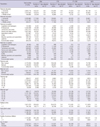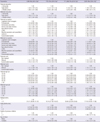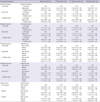1. Kramer MS, Seguin L, Lydon J, Goulet L. Socio-economic disparities in pregnancy outcome: why do the poor fare so poorly? Paediatr Perinat Epidemiol. 2000. 14:194–210.
2. Sanjose S, Roman E, Beral V. Low birthweight and preterm delivery, Scotland, 1981-84: effect of parents' occupation. Lancet. 1991. 338:428–431.
3. Rodriguez C, Regidor E, Gutierrez-Fisac JL. Low birth weight in Spain associated with sociodemographic factors. J Epidemiol Community Health. 1995. 49:38–42.
4. Olsen P, Laara E, Rantakallio P, Jarvelin MR, Sarpola A, Hartikainen AL. Epidemiology of preterm delivery in two birth cohorts with an interval of 20 years. Am J Epidemiol. 1995. 142:1184–1193.
5. Gruenwald P, Funakawa H, Mitani S, Nishimura T, Takeuchi S. Influence of environmental factors on foetal growth in man. Lancet. 1967. 1:1026–1028.
6. Butler NR, Alberman ED. Perinatal problems: the second report of the 1958 British perinatal mortality survey under the auspices of the national birthday trust fund. 1969. Edinburgh: Livingstone.
7. Eastman NJ, Jackson E. Weight relationships in pregnancy. I. The bearing of maternal weight gain and pre-pregnancy weight on birth weight in full term pregnancies. Obstet Gynecol Surv. 1968. 23:1003–1025.
8. Mengert WF. Fetal and neonatal mortality cause and prevention. Am J Obstet Gynecol. 1948. 55:660–668.
9. Anderson NA, Brown EW, Lyon RA. Cause of prematurity. Am J Dis Child. 1941. 61:72.
10. Shwartz S. Prenatal care, prematurity, and neonatal mortality. A critical analysis of prenatal care statistics and associations. Am J Obstet Gynecol. 1962. 83:591–598.
11. Robinson JS, Moore VM, Owens JA, McMillen IC. Origins of fetal growth restriction. Eur J Obstet Gynecol Reprod Biol. 2000. 92:13–19.
12. Rogers LK, Velten M. Maternal inflammation, growth retardation, and preterm birth: insights into adult cardiovascular disease. Life Sci. 2011. 89:417–421.
13. Ancel PY, Saurel-Cubizolles MJ, Di Renzo GC, Papiernik E, Breart G. Europop Group. Social differences of very preterm birth in Europe: interaction with obstetric history. Am J Epidemiol. 1999. 149:908–915.
14. Lee SY, Hong SC. Difference in incidence rate of low birth weight among the parental social strata in Korea. Health Soc Sci. 2003. 13:61–79.
15. Park JH, Lee BE, Park HS, Ha EH, Lee SW, Kim YJ. Association between pre-pregnancy body mass index and socioeconomic status and impact on pregnancy outcomes in Korea. J Obstet Gynaecol Res. 2011. 37:138–145.
16. Son M. The effects of the parents' social class on low birthweight among the birth, 1995-2001. Korean J Health Policy Adm. 2004. 14:148–168.
17. Hwang S, Jang J. The relationship between the supply and policy change in women's labour. 2003. Seoul, Korea: Korea Labour Institute.
18. Son M. Occupational class and health: the differentials in mortality, morbidity and workplace injury rates by occupation, education, income and working conditions in Korea. 2001. London School of Hygiene & Tropical Medicine, University of London;244–268. PhD thesis.
19. Mamelle N, Laumon B, Lazar P. Prematurity and occupational activity during pregnancy. Am J Epidemiol. 1984. 119:309–322.
20. Saurel-Cubizolles MJ, Kaminski M. Pregnant women's working conditions and their changes during pregnancy: a national study in France. Br J Ind Med. 1987. 44:236–243.
21. McDonald AD, McDonald JC, Armstrong B, Cherry NM, Nolin AD, Robert D. Prematurity and work in pregnancy. Br J Ind Med. 1988. 45:56–62.
22. Homer CJ, Beresford SA, James SA, Siegel E, Wilcox S. Work-related physical exertion and risk of preterm, low birthweight delivery. Paediatr Perinat Epidemiol. 1990. 4:161–174.
23. Henriksen TB, Hedegaard M, Secher NJ. Standing and walking at work and birthweight. Acta Obstet Gynecol Scand. 1995. 74:509–516.
24. Hickey CA, Cliver SP, Mulvihill FX, McNeal SF, Hoffman HJ, Goldenberg RL. Employment-related stress and preterm delivery: a contextual examination. Public Health Rep. 1995. 110:410–418.
25. Kim YA, Park JH. Impact of changes in maternal age and parity distribution on low birth weight incidence rate. Korean J Prev Med. 1989. 22:276–282.
26. Park MS, Park SH, Han JH, Kim EI. A study on factors affecting on low birth weight infants. J Reprod Med Popul. 1996. 9:5–14.
27. Park SH, Han JH, Kim SM, Ku SY, Kim SH. Risk factors of preterm delivery in pregnant women aged 35 years or older: analysis of birth certificate data in 1996. Korean J Obstet Gynecol. 1999. 42:1416–1421.
28. Romo A, Carceller R, Tobajas J. Intrauterine growth retardation (IUGR): epidemiology and etiology. Pediatr Endocrinol Rev. 2009. 6:Suppl 3. 332–336.
29. Launer LJ, Villar J, Kestler E, de Onis M. The effect of maternal work on fetal growth and duration of pregnancy: a prospective study. Br J Obstet Gynaecol. 1990. 97:62–70.
30. Teitelman AM, Welch LS, Hellenbrand KG, Bracken MB. Effect of maternal work activity on preterm birth and low birth weight. Am J Epidemiol. 1990. 131:104–113.
31. Klebanoff MA, Shiono PH, Carey JC. The effect of physical activity during pregnancy on preterm delivery and birth weight. Am J Obstet Gynecol. 1990. 163:1450–1456.
32. Oh EJ, Min HJ, Kim JH. Career choice and labor market transition of the married women by level of education. J Vocat Educ Train. 2009. 12:141–162.
33. Kim MR. The change of people's life during 6 years of neoliberalism. 95, Situation and Labor, Korean Institute of Labor Study and Policy. 2004. Seoul, Korea: 1–59.
34. Kim AE. The social perils of the Korean financial crisis. J Contemp Asia. 2004. 34:221–237.
35. Shin KY. Inequalities in social class in Korea. Econ Soc. 2003. 59:32–54.










 PDF
PDF ePub
ePub Citation
Citation Print
Print



 XML Download
XML Download